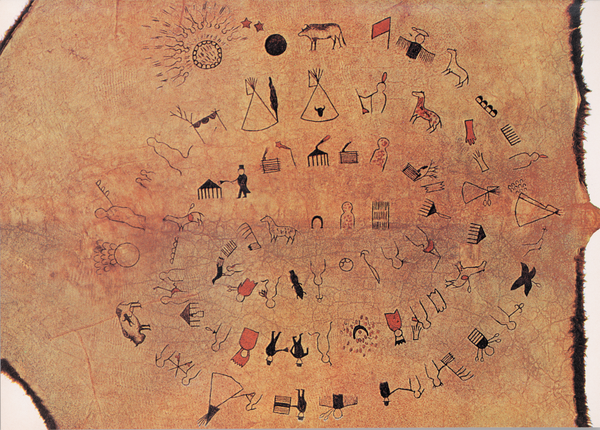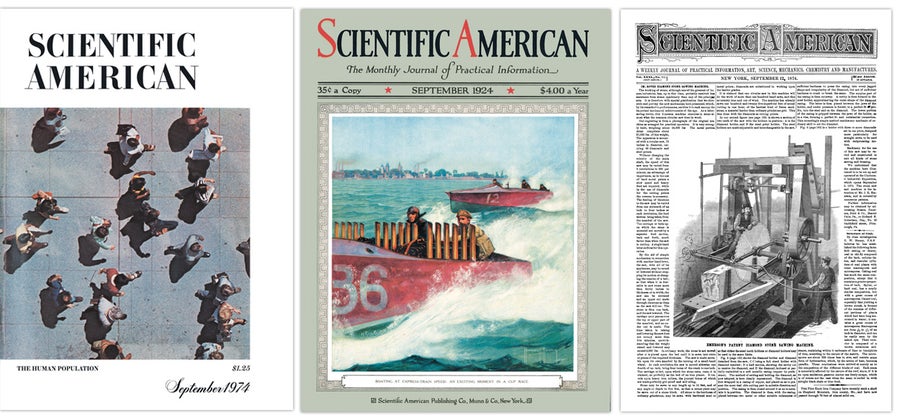August 20, 2024
3 min read
September 2024: Science History from 50, 100 and 150 Years Ago
Mysterious Mercury; spiders predict the weather

1974, Sioux Population: “Lone Dog’s ‘winter count,’ painted on the inside of a buffalo robe, chronicles 71 turbulent years in the migratory life of the Yankton tribe of the Sioux from the winter of 1800–1801 to that of 1870–1871. Each year is represented by a symbol recalling some memorable event. The record begins near the center and spirals outward counterclockwise.”
Scientific American, Vol. 231, No. 3; September 1974
1974
Mysterious Mercury: Like Moon or Mars?
“In the five months since the spacecraft Mariner 10 floated past Mercury, quantitative analyses of its instrumental data and 2,300 high-resolution photographs have revealed some surprises. The early photographs indicated that Mercury strongly resembles the moon. Measurements of the planet’s mass, however, indicate that unlike the moon (and like the earth) it must have a heavy core. The principal visible difference is that Mercury has a few scarps about three kilometers high, some of which are more than 500 kilometers long; there is no counterpart on the moon. Perhaps most puzzling is that Mercury, like the moon and Mars, is heavily cratered on one side and has wide, flat plains on the other. Why three of the five bodies in the inner solar system should be so asymmetrical is not clear.”
On supporting science journalism
If you’re enjoying this article, consider supporting our award-winning journalism by subscribing. By purchasing a subscription you are helping to ensure the future of impactful stories about the discoveries and ideas shaping our world today.
A Different Kind of Clock Radio
“Technological advances have relegated pendulum clocks to unreliable antiques. One such instrument, however, has been modernized by Laurance M. Leeds, who coupled his 80-year- old Seth Thomas wall clock to a quartz-crystal oscillator. The clock now ticks off the time to an accuracy of about one second per year. Week after week the old pendulum now ‘notches up’ the 60th second of every minute in almost exact coincidence with the signals of radio station WWV, on which the National Bureau of Standards broadcasts accurate time and frequency data.”
1924
Vitamin D, White Chemical of Life
“Food chemists have known about four or five vitamins for quite a few years, but [Walter] Eddy, [R. R.] Kerr and [Ralph] Williams of Columbia University are the first who have isolated any one of them. Vitamin D, sometimes called Bios, is the one without which you are in danger of having rickets. Vitamin D when isolated is a crystalline, white substance that looks like a dose of quinine. You cannot eat it straight. If you do, according to Kerr, you will regret it. The chemists say they don’t intend either to license the process of manufacture or to make it for sale themselves. They hope to show some day that life is simply a chemical process.”
1874
Spiders and Oxen Predict the Weather
“Curiously, a large number of animals seem able to predict the weather. Some of their actions appear to be more governed by reason than instinct, due to the moisture in the air or various atmospheric influences; the common garden spider, on the approach of rainy or windy weather, will be found to shorten and strengthen the supporting guys of its web, lengthening the same when the storm is over. Sea gulls assemble on the land, as they know that the rain will bring earthworms to the surface. Yet there is a large variety of actions of which it is hardly possible to give a satisfactory explanation. Coming rain is foretold by the peacock uttering frequent cries, by the woodpecker lamenting, by parroquets babbling and by geese running around uneasily. When a storm is at hand, swine will carry hay and straw to hiding places, oxen will lick themselves the wrong way of the hair, colts will rub their backs against the ground, crows will gather in crowds, frogs croak and change color to a dingier hue, dogs eat grass and rooks soar like hawks.”
Raining Ants and Herring
“An ant rain recently happened in Cambridge, England. At about six o’clock in the evening, shortly after a rise in temperature, a shower of ants in countless millions settled in the streets, covering the pavements. There is believed to be no record of an ant rain of such magnitude. We have also found a large number of cases of showers of fish, generally explicable by the occurrence of water spouts, which draw them up, whence carried by strong gales to the land. In Scotland rains of herrings have frequently occurred, the fish in some instances falling far inland. A shower of frogs fell near Toulouse in 1804. The rat shower of Norway was traced to a whirlwind, which, overtaking an enormous army of the rodents during their annual journey from a hilly region to the lowlands, whisked them up and deposited them in a field at considerable distance.”



































